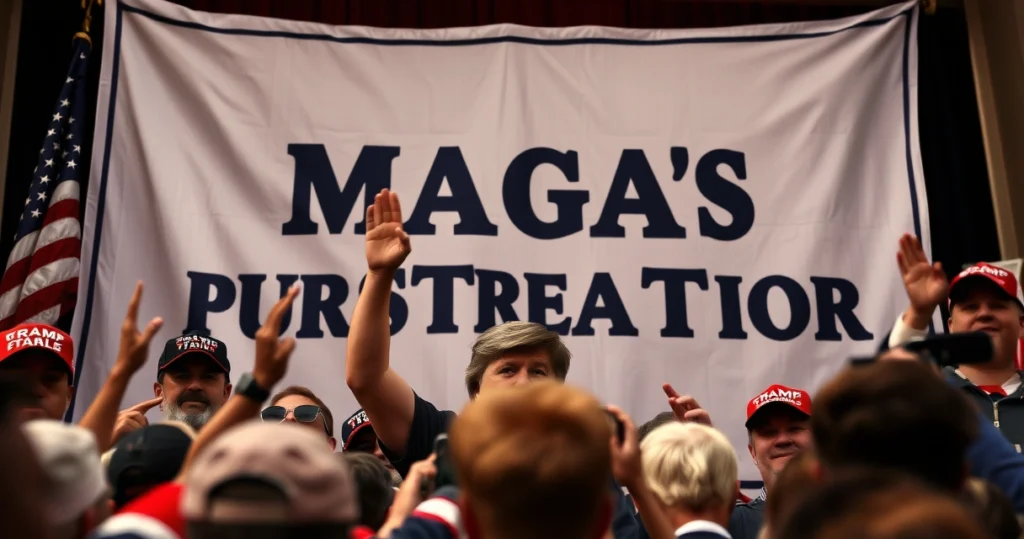In the tumultuous landscape of American politics, few phenomena have been as polarizing and fervent as the Make America Great Again (MAGA) movement led by former President Donald Trump. Initially, Trump’s rise to prominence was fueled by a deeply loyal base that thrived on his promises of economic revival, immigration reform, and a return to traditional American values. However, as time has progressed, segments of this base are expressing increasing frustration and feelings of betrayal regarding the administration’s failure to deliver on key issues that resonated with their values and aspirations. This article explores the roots of this discontent among Trump loyalists and examines the implications for the future of the MAGA movement.

The Promises That Fueled the MAGA Movement
To understand the frustrations of Trump’s loyal base, it is essential to revisit the cornerstone promises that galvanized support during his presidential campaign. Many of these pledges were grounded in a desire for dramatic change, appealing to voters who felt neglected by the political establishment.
One of the most compelling promises was economic revival. Trump vowed to bring back jobs lost to globalization, particularly in manufacturing sectors. His supporters believed that the administration’s policies, including tax cuts and deregulation, would lead to job creation and wage growth. For many, the success of these initiatives was seen as a direct reflection of Trump’s effectiveness and commitment to his base.
Another cornerstone of Trump’s platform was a crackdown on illegal immigration. The promise to build a wall along the southern border and to enforce stricter immigration laws resonated deeply with voters concerned about national security and job competition. Many loyalists viewed these measures as not only necessary but also a moral obligation to protect American sovereignty.
Despite the initial enthusiasm, a growing number of Trump loyalists are expressing frustration, feeling that the administration has not adequately addressed the issues that motivated their support. This perceived political betrayal can be attributed to several key factors.
Many voters feel that Trump’s administration has fallen short on several promises. For instance, the much-touted wall has not been completed, and immigration policies have faced numerous legal challenges, leading to inconsistent enforcement. This has left many loyalists feeling that their votes were in vain, further exacerbating feelings of discontent.
Economic conditions have also played a significant role in this discontent. While the administration initially saw economic growth, factors such as inflation and supply chain disruptions have led to increased frustration among voters who expected a robust recovery. Many feel that the promised benefits of Trump’s policies have not materialized, leading to disappointment and skepticism about the administration’s economic agenda.
The media landscape has dramatically changed since Trump first took office, often presenting narratives that conflict with his administration’s messaging. Disinformation, especially on social media, has fueled skepticism and division within the MAGA base. Many loyalists feel that they are not receiving the full story about the administration’s achievements or failures, leading to confusion and disappointment.
As alternative narratives gain traction, some loyalists are beginning to question their allegiance. The rise of competing voices within the Republican Party and the broader conservative movement has led to an environment where loyalty is tested. This fragmentation can be detrimental to the MAGA movement if left unaddressed.
<h2.Loyalists’ Response: Seeking Accountability
In response to their frustrations, many within the MAGA base are becoming increasingly vocal about their demands for accountability. They are actively seeking assurance that the administration will recommit to its foundational promises and provide tangible results.
Grassroots movements advocating for policy changes have gained momentum, as loyalists organize to hold elected officials accountable. These movements often focus on local issues, emphasizing the need for action on immigration, job creation, and economic policies. By mobilizing at the grassroots level, supporters aim to influence the direction of the MAGA movement and restore faith in its leadership.
The potential for electoral consequences looms large as discontent grows. If Trump fails to address the concerns of his loyal base, it could lead to decreased voter turnout in future elections. The MAGA movement’s viability may hinge on its ability to respond to the frustrations of its supporters and effectively communicate a roadmap for fulfilling the promises that initially garnered overwhelming support.
Important Points to Consider
- The MAGA movement was built on promises of economic revival and strict immigration reform.
- Many loyalists feel betrayed by unfulfilled promises, particularly regarding the completion of the border wall.
- Economic challenges, including inflation and supply chain issues, have fueled dissatisfaction among Trump supporters.
- The role of media and alternative narratives has contributed to a growing sense of confusion and frustration within the base.
- Grassroots movements are emerging as a response to demand accountability from the administration.
Frequently Asked Questions (FAQ)
1. Why do some MAGA supporters feel betrayed?
Many MAGA supporters feel betrayed because key promises, such as building the wall and economic recovery, have not been fulfilled. This disillusionment has grown, especially amid rising inflation and inconsistent immigration policy enforcement.
2. How has the media played a role in MAGA’s frustrations?
The media landscape has changed significantly, often presenting narratives that conflict with the administration’s messaging. This has led to confusion and skepticism among loyalists, who feel they are not receiving the full story about the administration’s achievements.
3. What are grassroots movements within the MAGA base advocating for?
Grassroots movements within the MAGA base are advocating for accountability from elected officials, focusing on local issues such as immigration reform, job creation, and economic policies that align with their original expectations.
4. What are the potential electoral consequences of MAGA’s discontent?
If the Trump administration fails to address the concerns of its loyal base, it could lead to decreased voter turnout in future elections, impacting the overall viability of the MAGA movement.
5. How can the MAGA movement regain the trust of its loyalists?
The MAGA movement can regain trust by recommitting to its foundational promises, providing tangible results, and effectively communicating a clear roadmap for action to address the concerns of its supporters.
Conclusion
The frustration among Trump’s loyal base is a complex issue rooted in unfulfilled promises, economic challenges, and evolving narratives within the media landscape. As MAGA supporters increasingly seek accountability, the movement’s future may depend on its ability to address these concerns effectively. Rebuilding trust and ensuring that the administration remains committed to its core promises will be essential in retaining the loyalty of its base as the political landscape continues to evolve. The challenge lies in understanding the depth of this frustration and translating it into actionable policies that resonate with the very voters who propelled Trump to prominence.
📰 Original Source
Este artigo foi baseado em informações de: https://www.wired.com/story/jeffrey-epstein-list-maga-angry-trump/



